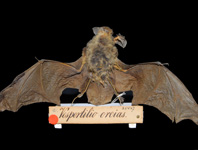Abstract
Vespertilio oreias (generally known as Myotis oreias) has long been considered an endemic bat species to Singapore but its taxonomic status has been in doubt, and no specimens have been found since its description in 1840. Temminck formally described it based on a mounted skin (now in poor condition and accompanied by some skull fragments). The holotype was re-examined and we found it to be a composite, consisting of two separate individuals representing two distinct genera, the skin belonging to a Kerivoula whereas the skull fragments are of a Myotis. The mounted skin is accepted herewith as the name-bearing type, as the skull fragments were taken out after Temminck had published his description. Unfortunately, neither the skin nor the dental remains show enough anatomical details to identify the species unambiguously. Hence, the name Vespertilio oreias is considered a nomen dubium and the name oreias should be referred to the genus Kerivoula.
References
Baker, N. & Lim, K.K.P. (2008) Wild Animals of Singapore - A Photographic Guide to Mammals, Reptiles, Amphibians and Freshwater Fishes, 2nd edition. Draco Publishing and Distribution Pte Ltd and Nature Society (Singapore), Singapore, 180 pp.
Collar, N.J. (1998) Extinction by assumption; or, the Romeo Error on Cebu. Oryx, 32, 239–244.
http://dx.doi.org/10.1046/j.1365-3008.1998.d01-51.x
Csorba, G. & Bates, P.J.J. (2008) Myotis oreias. The IUCN Red List of Threatened Species. Version 2015.2. Available from: http://www.iucnredlist.org (accessed 3 August 2016)
Francis, C.M. & Hill, J.E. (1998) New records and a new species of Myotis (Chiroptera, Vespertilionidae) from Malaysia. Mammalia, 62, 241–252.
http://dx.doi.org/10.1515/mamm.1998.62.2.241
Hasan, N.H. & Abdullah, M.T. (2011) A morphological analysis of Malaysian Kerivoula (Chiroptera: Vespertilionidae). Mammal Study, 36, 87–97.
http://dx.doi.org/10.3106/041.036.0207
International Commission on Zoological Nomenclature (1999) International Code of Zoological Nomenclature. 4th Edition. The Natural History Museum, London.
Jentink, F.A. (1887) Catalogue ostéologique des mammifères. Muséum d’Histoire Naturelle des Pays-Bas, 9, 1–360.
Jentink, F.A. (1888) Catalogue systématique des mammifères (rongeurs, insectivores, cheiroptères, édentées et marsupiaux). Muséum d’Histoire Naturelle des Pays-Bas, 12, 1–280.
Khan, F.A.A., Solari, S., Swier, V.J., Larsen, P.A., Abdullah, M.T. & Baker, R.J. (2010) Systematics of Malaysian woolly bats (Vespertilionidae: Kerivoula) inferred from mitochondrial, nuclear, karyotypic, and morphological data. Journal of Mammalogy, 91, 1058–1072.
http://dx.doi.org/10.1644/09-mamm-a-361.1
Kingston, T. (2010) Research priorities for bat conservation in Southeast Asia: a consensus approach. Biodiversity and Conservation, 19, 471–484.
http://dx.doi.org/10.1007/s10531-008-9458-5
Kingston, T. (2013) Response of bat diversity to forest disturbance in Southeast Asia: insights from long-term research in Malaysia. In: Adams, R.A. & Pedersen, S.C. (Eds.), Bat Evolution, Ecology, and Conservation. Springer, New York, pp. 169–185.
Kingston, T., Lim, B.L. & Zubaid, A. (2006) Bats of Krau Wildlife Reserve. Penerbit Universiti Kebangsaan Malaysia, Bangi, 145 pp.
Lane, D.J.W., Kingston, T. & Lee, B.P.Y.-H. (2006) Dramatic decline in bat species richness in Singapore, with implications for Southeast Asia. Biological Conservation, 131, 584–593.
http://dx.doi.org/10.1016/j.biocon.2006.03.005
Medway, L. (1978) The wild mammals of Malaya (Peninsular Malaysia) and Singapore. Oxford University Press, Kuala Lumpur, 156 pp.
Ng, P.K.L. & Wee, Y.C. (1994) The Singapore Red Data Book: threatened plants and animals of Singapore. Nature Society (Singapore), Singapore, 348 pp.
Pottie, S.A., Lane, D.J.W., Kingston, T. & Lee, B.P.Y.-H. (2005) The microchiropteran bat fauna of Singapore. Acta Chiropterologica, 7, 237–247.
http://dx.doi.org/10.3161/1733-5329(2005)7[237:tmbfos]2.0.co;2Struebig, M.J., Huang, J.C.C., Mohamed, N.Z., Noerfahmy, S., Schöner, C.R., Schöner, M.G. & Francis, C.M. (2016) Forest surveys extend the range of the Krau woolly bat (Kerivoula krauensis) in the Malay-Thai Peninsula, Borneo and Sumatra. Mammalia, [ahead-of-print]
http://dx.doi.org/10.1515/mammalia-2015-0114
Tate, G.H.H. (1941) A review of the genus Myotis (Chiroptera) of Eurasia, with special reference to species occurring in the East Indies. Bulletin of the American Museum of Natural History, 78, 537–565.
Temminck, C.J. (1840) Treizième monographie sur les cheiroptères verspertilionides formant les genres nyctice, vespertilion et furie. In: Monographies de mammalogie, ou description de quelques genres de mammifères, dont les espèces ont été observées dans les différens musées d’Europe. Tome second. C. C. van der Hoek, Leiden / Ed. d’Ocagne & A. Bertrand, Paris, pp. 141–272.
Thong, V.D., Dietz, C., Denzinger, A., Bates, P.J.J., Puechmaille, S.J., Callou, C. & Schnitzler, H.-U. (2012) Resolving a mammal mystery: the identity of Paracoelops megalotis (Chiroptera: Hipposideridae). Zootaxa, 3505, 75–85.
Vanitharani, J., Rajendran, A., Bates, P.J.J., Harrison, D.L. & Pearch, M.J. (2003) A taxonomic reassessment of Kerivoula lenis Thomas, 1916 (Chiroptera: Vespertilionidae) including a first record from peninsular India. Acta Chiropterologica, 5, 49–60.
http://dx.doi.org/10.3161/001.005.0104
Woodruff, D.S. & Turner, L.M. (2009) The Indochinese-Sundaic zoogeographic transition: a description and analysis of terrestrial mammal species distributions. Journal of Biogeography, 36, 803–821.
http://dx.doi.org/10.1111/j.1365-2699.2008.02071.x
Yang, C.M., Yong, K. & Lim, K.P. (1990) Wild mammals of Singapore. In: Chou, L.M. & Ng, P.K.L. (Eds.), Essays in Zoology. Department of Zoology, National University of Singapore, Singapore, pp. 1–23.

